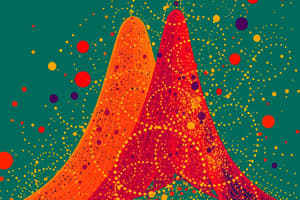Podcast
Questions and Answers
What is the key property of the standard normal curve?
What is the key property of the standard normal curve?
- It has a constant standard deviation
- It has a mean of 0 and a variance of 1 (correct)
- It is positively skewed
- It is bimodal
Which of the following best describes the relationship between standard deviation and variability?
Which of the following best describes the relationship between standard deviation and variability?
- Standard deviation is a measure of central tendency, not variability
- Standard deviation and variability are inversely related
- Standard deviation and variability are directly related (correct)
- Standard deviation and variability are unrelated
What is the purpose of calculating z-scores?
What is the purpose of calculating z-scores?
- To determine the probability of a value occurring
- To find the median of a dataset
- To calculate the standard deviation of a dataset
- To compare values from different datasets with different scales (correct)
Which of the following is NOT a descriptive measure used to summarize data?
Which of the following is NOT a descriptive measure used to summarize data?
How does the sampling distribution relate to the population distribution?
How does the sampling distribution relate to the population distribution?
Which of the following statements about the standard deviation of a discrete probability distribution is true?
Which of the following statements about the standard deviation of a discrete probability distribution is true?
What is the defining characteristic of a simple random variable?
What is the defining characteristic of a simple random variable?
In a discrete probability distribution, what does the distribution function assign to each integer value?
In a discrete probability distribution, what does the distribution function assign to each integer value?
If the mean of a discrete probability distribution is denoted by μ, what does it represent?
If the mean of a discrete probability distribution is denoted by μ, what does it represent?
What does the standard deviation measure in a probability distribution?
What does the standard deviation measure in a probability distribution?
If a fair coin is tossed three times, what is the probability of getting exactly two heads?
If a fair coin is tossed three times, what is the probability of getting exactly two heads?
What is a sampling distribution?
What is a sampling distribution?
Flashcards are hidden until you start studying
Study Notes
Statistics and Probability
Simple Random Variables
A simple random variable is a single numerical output of a random process. These variables are represented by capital letters, like X, Y, and Z. They can take any real value, which depends on the experimental trial or experiment conducted. For example, if you roll a die, the value 1, 2, 3, 4, 5, or 6 represents a simple random variable.
Discrete Probability Distribution
In discrete probability distributions, the random variable takes integer values, like the number of heads obtained when tossing coins repeatedly. The distribution function assigns a positive value to every integer value, indicating the probability that the random variable takes that particular value. For instance, when tossing a biased coin, the probability of getting heads is 0.7, and the probability of getting tails is 0.3.
Mean of Discrete Probability Distribution
The mean of a discrete probability distribution is calculated as the weighted average of all possible values. It represents the expected value of the random variable. For example, if the mean of a discrete probability function is μ, it indicates the weighted average of all possible values, considering their respective probabilities.
Standard Deviation
Standard deviation measures the dispersion or spread of the values around their mean. In discrete probability distributions, it is calculated as the square root of the variance, which is the average of the squared differences between each value and the mean. A larger standard deviation implies a wider range of potential values, suggesting greater variability.
Standard Normal Curve
The standard normal curve is a bell-shaped curve that describes the distribution of probabilities for a standard random variable. It is derived from the Gaussian distribution, where the variable has zero mean and unit variance. This curve is symmetric and widely used in various statistical analyses, including hypothesis testing and confidence intervals.
Z Scores and Z Values
Z scores represent the number of standard deviations away from the mean, in units of standard deviation. Similarly, z values indicate the position of the score along the standard normal curve. Both concepts are crucial for comparing values from different datasets with different scales and measuring deviations from expected results.
Sampling and Sampling Distribution
Sampling involves selecting a subset of observations from a population to estimate the characteristics of the entire population. By calculating descriptive statistics on the sample, researchers can make inferences about the population parameters. Sampling distribution refers to the probability distribution of the sample means when multiple samples are drawn from the same population.
Descriptive Measures
To summarize data effectively, descriptive measures like mean, median, and mode are used. These statistics provide valuable insights into the distribution of data and help identify trends or patterns. For instance, the mean represents the average value of the dataset, while the median indicates the middle value when all values are arranged in order. The mode is the most frequently occurring value if there is more than one such value.
Studying That Suits You
Use AI to generate personalized quizzes and flashcards to suit your learning preferences.




